
a web page by Don Roberson |
 |
||
SANDGROUSE Pteroclidae |
||
|
||
Sandgrouse are often seen in pairs or family groups, but join flocks at waterholes or enroute to waterholes. Yellow-throated Sandgrouse is a rather large species in east Africa (pair left; small flock in flight, above). |
||
In east Africa, Black-faced Sandgrouse (below) is another exceptionally lovely species. All sandgrouse have upperpart feathering that makes then difficult to see when viewed from above (as by an avian predator) but females are often patterned to be hidden from view when sitting on a nest (see the protective pattern on the female Yellow-throated Sandgrouse above). Although both parents incubate the eggs in most species, males often incubate at night while the females sit on the eggs during the day and have evolved additional camouflage (de Juana 1997). |
||
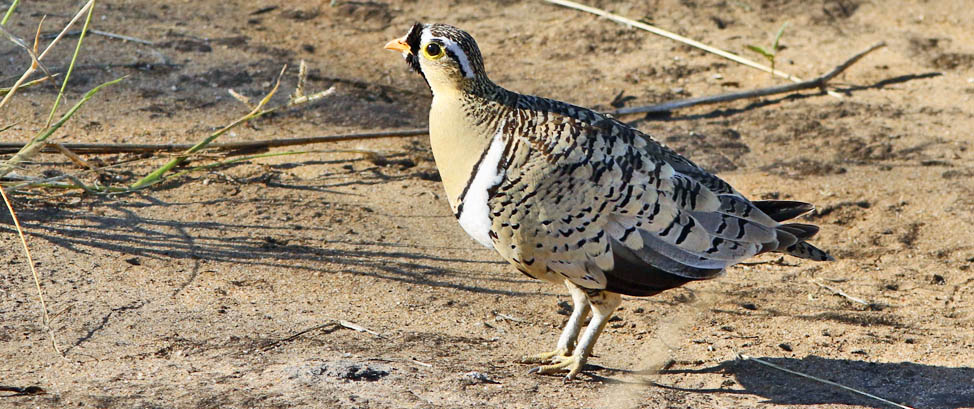 |
||
| Because the original specimens recalled small long-winged grouse, Linnaeus originally assigned them to the same genus as European grouse. As described by de Juana (1997), this was disputed in 1867 when Thomas Huxley reviewed their skeletons and came to the conclusion they were "perfectly balanced" between grouse and pigeons, and assigned them to their own distinctive order "Pteroclomorphae." Over time, the idea they were related to grouse at all was slowly dropped and by the mid-20th century many placed them as a suborder among the pigeons. This changed in 1967 when G. L. Maclean proposed a relationship between sandgrouse and shorebirds, based primarily on field observations. The fact they do not drink like pigeons, they don't give cooing sounds, they don't build stick nests, that their eggs were pigmented (not white) and that the young can immediately fend for themselves are all reasons they aren't that close to pigeons. By the time de Juana & Hoyo (1997) was published, they were assigned their own order Pterocliformes. Today, based on DNA molecular evidence, sandgrouse are placed rather early in the sequence of families between the pigeons (order Columbiformes) and bustards (order Otidiformes; Hackett et al. 2008, Prum et al. 2015). | ||
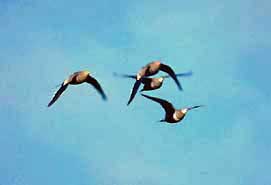 One
special feature of sandgrouse is their long flights to water holes in
desert and semi-desert country where not only do they drink, but during
breeding they wet their belly feathers to carry water to the chicks.
The male's belly feathers are specially adapted to hold up to 15-20 ml
of water. The nests may be over 25 miles distant, and it may take
several trips, but adults carry enough water back to their chicks so
that they survive. Here (at left), flocks of Chestnut-bellied Sandgrouse are flying in to land at East African pools. Burchell's Sandgrouse
in the Kalahari desert has been known to fly over 100 miles each day to
water. By waiting at a Kalahari waterhole, I obtained these photos of a
female (below left) and then a bathing male (below right). One
special feature of sandgrouse is their long flights to water holes in
desert and semi-desert country where not only do they drink, but during
breeding they wet their belly feathers to carry water to the chicks.
The male's belly feathers are specially adapted to hold up to 15-20 ml
of water. The nests may be over 25 miles distant, and it may take
several trips, but adults carry enough water back to their chicks so
that they survive. Here (at left), flocks of Chestnut-bellied Sandgrouse are flying in to land at East African pools. Burchell's Sandgrouse
in the Kalahari desert has been known to fly over 100 miles each day to
water. By waiting at a Kalahari waterhole, I obtained these photos of a
female (below left) and then a bathing male (below right). |
||
|
||
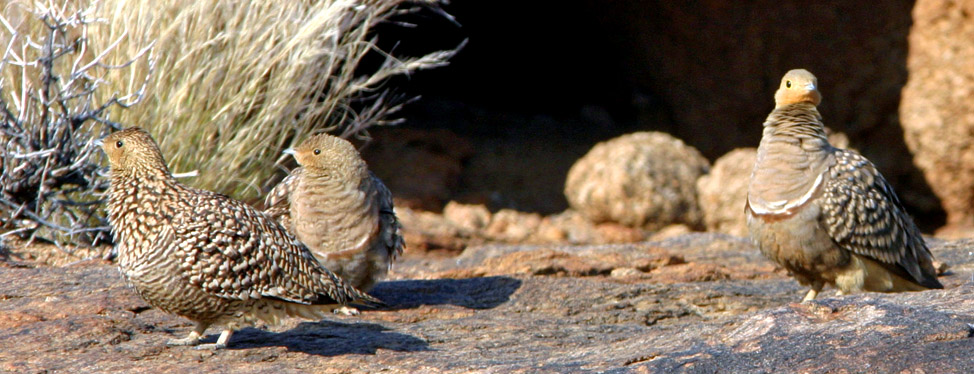 |
||
|
There are two species in the genus Syrrhaptes that live from the Tibetan plateau to Mongolia. One of them, the Pallas's Sandgrouse S. paradoxus, stages irregular irruptions that spin off vagrants far from these remote steppes. Irruptions in 1863, 1888, and 1908 sent some birds all the way to western Europe!
|
||
Photos: Both the flying group and the pair of Yellow-throated Sandgrouse Pterocles gutturalis were at Tarangire NP, Tanzania, on 8 June 2008. The male Lichtenstein's Sandgrouse Pterocles lichtensteinii was at Samburu NP, Kenya, on 15 Nov 1981. The male Black-faced Sandgrouse Pterocles decoratus was on the road in Tarangire NP, Tanzania, on 10 June 2018. The flying Chestnut-bellied Sandgrouse Pterocles exustus were at Amboseli NP, Kenya, in Nov 1981. The shots of a female and then a male Burchell's Sandgrouse Pterocles burchelli at Kalahari NP, South Africa, on 13 July 2005. The family group of Namaqua Sandgrouse Pterocles namaqua were at Augrabes NP, South African, in July 2005. The Double-banded Sandgrouse Pterocles bicinctus was crossing a road in Kruger Nat'l Park, South Africa, on 31 July 1996. All photos © Don Roberson; all rights reserved. Bibliographic note: There is no "family book" per se but a good introduction to this family, with some fine photos, is in de Juana (1997). Literature cited:
|
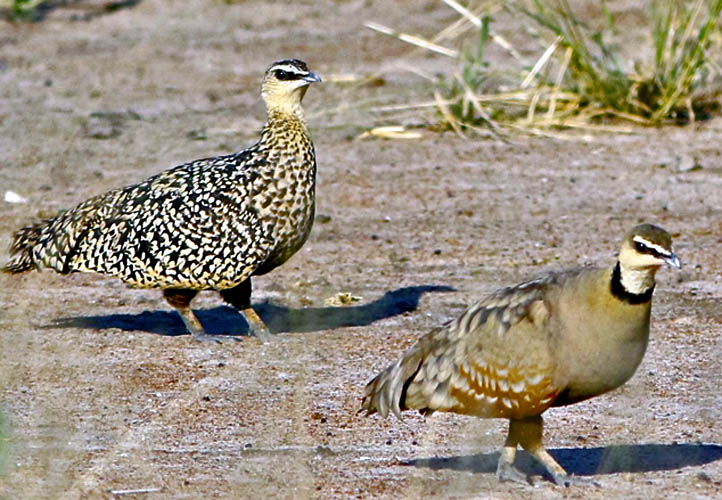 Sandgrouse
are found only in Africa and Eurasia. They are primarily ground-feeding
birds of deserts, scrub, and grasslands. Sandgrouse share several
attributes of pigeons, including their long wings and the practice of
making long flights daily between breeding or feeding grounds and pools
of water at which they drink. The relationship of sandgrouse to other
groups has been hotly debated issues over a period of centuries.
Sandgrouse
are found only in Africa and Eurasia. They are primarily ground-feeding
birds of deserts, scrub, and grasslands. Sandgrouse share several
attributes of pigeons, including their long wings and the practice of
making long flights daily between breeding or feeding grounds and pools
of water at which they drink. The relationship of sandgrouse to other
groups has been hotly debated issues over a period of centuries. 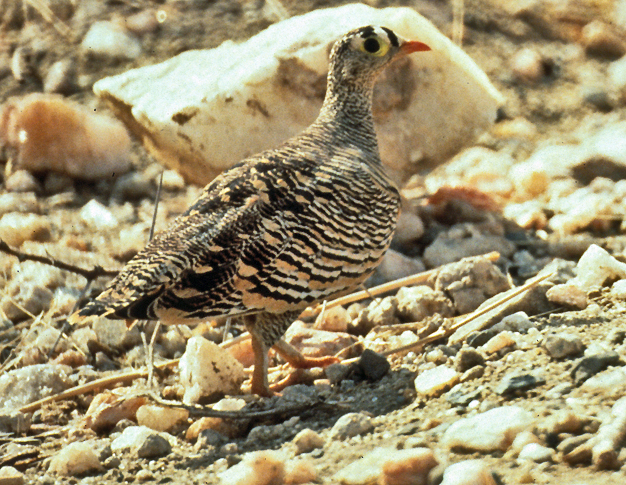 Lichtenstein's Sandgrouse
(left) of North Africa and the Middle East, one of the most
desert-loving of all species. Its beautifully patterned upperparts
provide fine camouflage amongst its pink & white rocky habitat. It,
like all sandgrouse, has feathered tarsi.
Lichtenstein's Sandgrouse
(left) of North Africa and the Middle East, one of the most
desert-loving of all species. Its beautifully patterned upperparts
provide fine camouflage amongst its pink & white rocky habitat. It,
like all sandgrouse, has feathered tarsi. 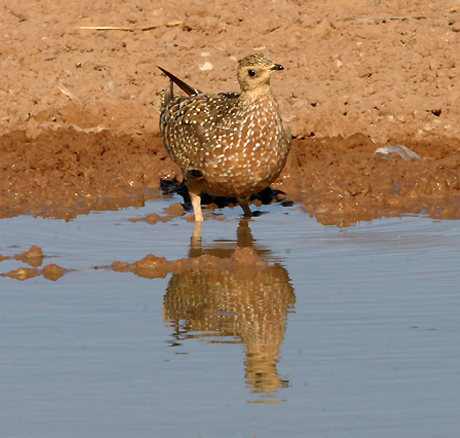

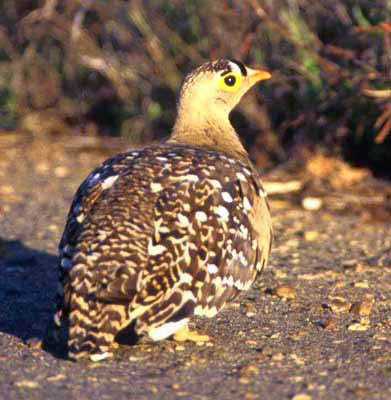 Most
of the world's sandgrouse are rather closely related to each other and
all but two are considered to be within a single genus Pterocles. Two South African examples are Namaqua Sandgrouse (family group above, male on the right) and Double-banded Sandgrouse (male, left).
Most
of the world's sandgrouse are rather closely related to each other and
all but two are considered to be within a single genus Pterocles. Two South African examples are Namaqua Sandgrouse (family group above, male on the right) and Double-banded Sandgrouse (male, left).